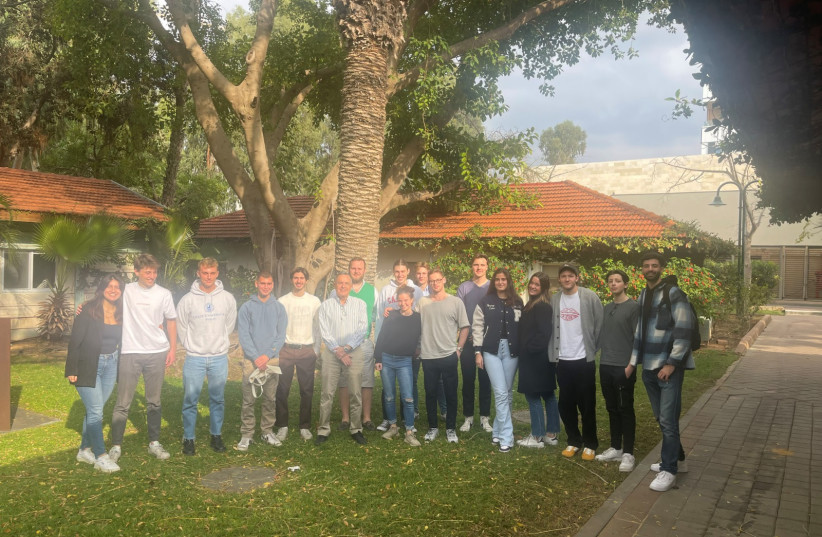For Jonathan Davis, the events of the Yom Kippur War, which took place fifty years ago in October of 1973, remain fresh in his mind. In a recent interview with the Jerusalem Post, Davis, Vice President for External Relations and Head of the Raphael Recanati International School at Reichman University, shared his feelings and experiences about three events that took place during that tumultuous period in Israel’s history, and how these events relate to his work at Reichman University. Davis sums up his war experiences succinctly. “I saw combat, and I risked my life during that period. It was intensive and traumatic, and I was happy to be alive.”
In 1969, Davis, a native Californian and student at Columbia University, came to Israel to study in a one-year program at Hebrew University. He fell in love with the land and decided to remain, completing his undergraduate degree program and serving in the IDF. Davis was a lone soldier – a term that did not exist then – and was in a paratrooper reconnaissance unit.
Shortly before the war broke out, Davis, together with fifteen soldiers carefully selected from elite units, each with mother tongue knowledge of other languages, was preparing for a clandestine military operation scheduled to be carried out behind Egyptian lines. The soldiers, led by Yoni Netanyahu, who was later killed in the Entebbe rescue in 1976, were training to break into a prison in Egypt and free Israeli soldiers who had been captured during the War of Attrition. Once the war began, the operation was canceled. Three of the fifteen were killed in the Yom Kippur War.
Davis’s second significant experience occurred during the war itself, when he participated in a mission near the Syrian-Iraqi border, under the command of Shaul Mofaz, later to become IDF Chief of Staff. Davis and a group of soldiers were trapped on a hilltop, and his platoon was rescued by the 118 Helicopter Squadron of the Israeli Air Force, in what Davis says was one of the most courageous rescues ever done by the squadron.

The third incident occurred at the war’s end, when Davis returned to his tiny apartment in Jerusalem’s Kiryat Yovel neighborhood. Davis was somewhat aloof from the Georgian Jews living in the building and had little connection with them. Upon returning to his apartment, he was miffed to find that his mailbox had been painted bright red and that the paint had glued the letters together. “I thought very highly of myself at that time,” Davis wryly recalls. “I was a lone soldier from California who understood more and thought he was better than them in some egocentric way.”
Angered at the apparent vandalization of his mailbox and its contents, Davis confronted one of the Georgian elders who lived in his building and complained about their seeming disregard for him, given that he had just returned from the fighting in Egypt. “The elder looked at Davis and replied, “We knew that you were the only one in this building who went to war, and we painted your mailbox red so that the Angel of Death would skip over your threshold and spare you.” Davis was touched by his response and realized that the Jews in his building truly cared for him, and together, they shared a common destiny.
Contemplating these events fifty years later, Davis says, “The reflections of the war are the willingness to sacrifice and possibly die for the State of Israel. I was the only lone soldier in the paratrooper reconnaissance unit. There were very few lone soldiers during that period. No one in the army at that time understood what a lone soldier was.”
Davis says he has come full circle from being a little-known IDF soldier from California to where he is today. “Now I head the Raphael Recanati International School on campus, where we have close to 300 former lone soldiers out of 2,500 students in the International School. I am battling for those lone soldiers. I did everything I could to help some of them get admitted. I gave them extra credit, especially when they were in combat units, and did everything I could to be able to help them.”
He recalls his own Israeli university experiences shortly after the Yom Kippur War when a professor refused to give him an extension to hand in a seminar paper, though he had been in the war and was unable to finish the paper on time. “It traumatized me,” he says, “and that is the difference between that university and the philosophy of Reichman University.”
Continuing, Davis adds, “At Reichman University, if you serve in the IDF reserves for at least ten days, you receive two academic credits as an elective. If you are a former officer in a combat unit, you don’t have to take the psychometric exam. You just need to show your Bagrut (matriculation certificate). We give preferential treatment to combat officers when they apply to Reichman University.”
Recalling how lone soldiers were treated when he served in the IDF, Davis says, “I have an opportunity to rectify things. Reichman students who are serving in the IDF reserves receive free private lessons, if they need, for the material they missed while they were serving. If their reserve duty took place during exams, we will create a special exam for them on another day. For me, the full circle is the Yom Kippur War, the trauma of almost getting killed, of sacrifice and values, and 50 years later, being on this campus, able to help reservists and lone soldiers and take students by the hand.”
Finally, recalling the actions of his Georgian neighbors who painted his mailbox to ensure his protection, he says, “What those Georgian Jews did, was to explain to me how the Jewish world is united – that the blood that flows in our veins is the same blood. We are all equals here.”
This article was written in cooperation with Reichman University
